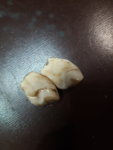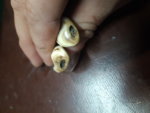Lots at play there, between antler size and points, body size, and tooth wear, that all can help point to an approximate age class. I never rely solely on canine wear as I always look at the teeth on the lower jaw too. As elk age and pass their prime, antler size will begin to drop if they live long enough. Although you usually don’t see that until much later on. Antler size is also dependent on the quality of food and amount of stress the cow had consumed or was exposed to when that bull was in the womb, more so than after that bull hit the ground and the years after that. Additionally, where soils are very sandy and gritty, elk will be consuming portions of that daily with their diet. That’ll change wear patterns enough to really skew tooth wear patterns. In those instances, sectioning a tooth is required to get the accurate age of the animal. I’m not familiar with the area you killed that bull, so take all of what I’m saying as being a generality and not gospel! Congrats on the harvest. If those canines are worn due to age, that’s pretty neat as few hunters get to see that in most areas because us hunters do a tremendous job killing mature bulls. And rightfully so!



